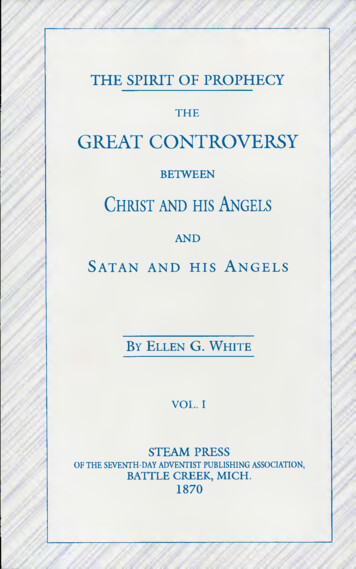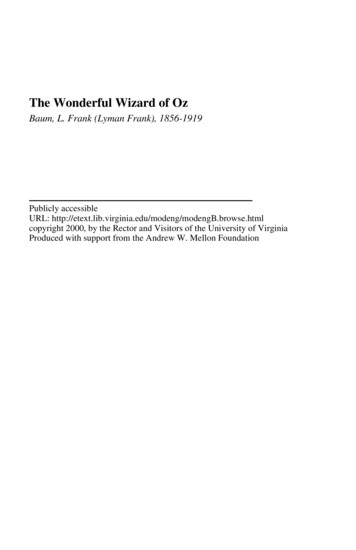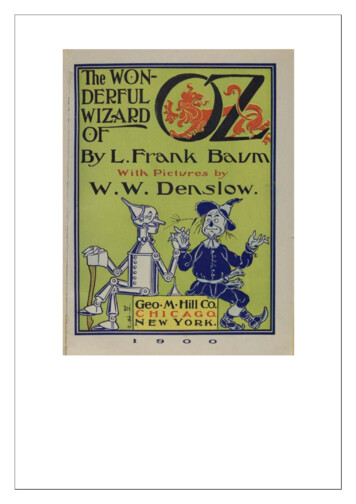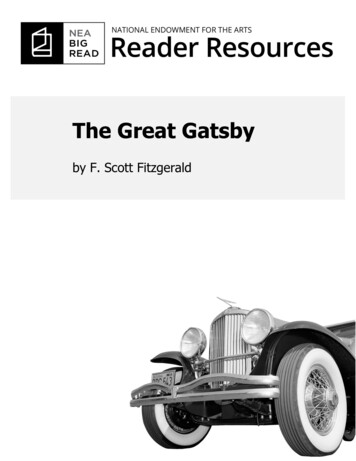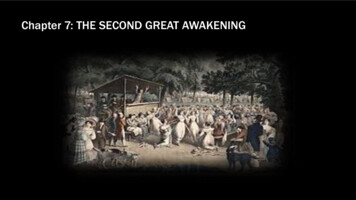
Transcription
Chapter 7: THE SECOND GREAT AWAKENING
Objectives: We will study the SecondGreat Awakening andhow it impacted postRevolution Americaculturally. We still study how theywere a counterpoint torationalism/enlightenment ideals.
“And I took the little book out of theangel's hand, and ate it up; and itwas in my mouth sweet as honey:and as soon as I had eaten it, mybelly was bitter. And he said untome, Thou must prophesy againbefore many peoples, and nations,and tongues, and kings.”Revelation 10:10-11
THE SECOND GREAT AWAKENING: The origins of the SecondAwakening lay in the efforts ofconservative theologians ofthe 1790s to fight the spreadof religious rationalism. It encouraged churchestablishments to revitalizetheir organizations.
THE SECOND GREAT AWAKENING: Leaders of several differentdenominations participated in theevangelizing efforts and drove therevival. Presbyterians tried to arouse thefaithful on the western fringe on whitesettlement, and conservatives in thechurch denounced New LightDissenters. New Light dissenters altered theirreligious views to make them morecompatible with the world of scientificrationalism.
THE SECOND GREAT AWAKENING: Methodism which John Wesleyhad founded in England,spread to America in the1770s. Became a formal denominationin 1784 under the leadershipof Francis Ashbury.
THE SECOND GREAT AWAKENING: Authoritarian and hierarchal instructure, the Methodist Church senttraveling preachers throughout thenation to win recruits; it soonbecame the fastest growingdenomination in America. Almost as successful were Baptists,who were themselves relatively newto America; they found an especiallyfervent following in the South.
THE SECOND GREAT AWAKENING: By 1800 the revivalist energies of allthese denominations were combining tocreate the greatest surge of evangelicalfervor since the first Great Awakeningsixty years before. Beginning among Presbyterians inseveral eastern colleges (most notablyat Yale, under the leadership ofPresident Timothy Dwight) the newawakening soon spread rapidlythroughout the country reaching itsgreatest heights in the western regions.
THE SECOND GREAT AWAKENING: In only a few years, many Americans were mobilized bythe movement and joined these churches embracingrevival. Most joined the Methodists, Baptists, and Presbyterians. At Cane Ride, Kentucky, the summer of 1801, a group ofevangelical ministers presided over the nation’s firstcamp meeting. The Camp meeting was an extraordinary revival thatlasted several days and impressed all who saw it with itssize (some estimated that 25,000 people attended) andits fervor. Such events became common in subsequent years, asthe Methodists in particular came to rely on them as away to “harvest” new members.
THE SECOND GREAT AWAKENING: The basic thrust of the GreatAwakening messages were clear,Individuals must readmit God andChrist into their daily lives. One must embrace a fervent, activepiety, and must reject the skepticalrationalism that threatenedtraditional beliefs. Even so, the wave of revivalism didnot serve to restore the religiousideas of the past.
THE SECOND GREAT AWAKENING: Few of the revivalist denominationsany longer accepted the idea ofpredestination, the belief that aperson could affect his or her owndestiny added intensity to theindividual’s search for salvation. The Awakening, in short combineda more active piety with a belief inGod as an active force in the worldwhose grace could be attainedthrough faith and good works.
THE SECOND GREAT AWAKENING: The Second Great Awakening alsoaccelerated the growth ofdifferent sects anddenominations. It helped create a broad popularacceptance of the idea that menand women could belong todifferent Protestant churches andstill be committed to essentiallythe same Christian faith.
THE SECOND GREAT AWAKENING: Finally, the new evangelism, byspreading religious fervor intovirtually every area of thenation, provided a vehicle forestablishing a sense of order. It also provided social stabilityin communities still searchingfor an identity.
Another movement was the Milleritemovement. Founded by William Miller, a farmerfrom upstate New York. Miller was originally a deist.
Miller had a conversion experienceafter a battle he fought as a Captain ofthe U.S. Army in the War of 1812 inupper New York. They were outnumbered three to oneand yet they somehow defeated theBritish. This experience caused Him to realizethat God does intervene in people’slives.
He committed to the Baptist churchand began systematically to studythe Bible. Miller studies Daniel andRevelation based on Daniel 8:14,that Jesus would most likely returnin 1843-1844. This is based on the prophecy onDaniel 8:14, where it states thatafter 2300 days, the sanctuarywould be cleansed.
Miller saw that the 2300 days were 2300years (Numbers 14:34, Ezekiel 4:6) andthis prophecy was connected to a prophecyin Daniel 9 where the beginning of theprophecy was in 457 B.C. with the decreefor Jerusalem to be rebuilt given by thePersian King Artaxerxes. He believed that the term sanctuaryrepresented the earth, and the sanctuarybeing cleansed with the earth beingcleansed by fire by the second coming ofJesus.
In mark contrast to Finney,Miller believed that JesusChrist will return and gatherHis believers to Heaven, andscorch the earth with fire,destroying the wicked. The faithful will reside inHeaven for a thousand years,and return to a newly createdEarth.
Interested in the second Coming ofJesus and the historicist view ofBible prophecy increased with thefollowing Prophecies fulfilled. The arrest of Pope Pius VI byNapoleon’s Army in 1798 was seenas a fulfillment of Bible prophecy(Daniel 7:25, Revelation 12:5-6,Revelation 13:5-7). End of the 1,260 years of Papalpolitical domination.
The ominous dark day of19 May 1780, where theday inexplicably wentdark as night in thenortheast. The great star shower of13 November 1833(Matthew 24:29, Luke21:25-26, Revelation6:12)
This was a historicist view ofBible Prophecy is whereBible prophecy being fulfilledthroughout both in the past,present, and is fulfilling inthe future. It was different from thecommon view that Bibleprophecy was thought of allbeen fulfilled in the past orall will be fulfilled in thefuture.
Miller’s interpretations began to bepublished in Baptist publications. Miller’s views attracted those whoopposed slavery (abolitionists), andthose who opposed alcohol (temperancemovements). Anti-slavery activist William LloydGarrison worked with Millerite Josiah V.Himes in anti-slavery causes. Millerite Joseph Bates was active in antislavery and temperance (anti-alcoholand anti-smoking causes).
Large camp meetings with hugetents traveled from city to city, townto town. Attracting hundreds. Many were also attracted by theprophecy charts and diagrams ofthe various symbols found in thebooks of Daniel and Revelation. Methodists, Baptists, andPresbyterians and other Christiansjoined the movement. The Millerites were called“Adventists” those who believe inthe coming or return of Jesus.
But in October 22, 1844, Jesus did not return, this wascalled the Great Disappointment. The Millerite followers had up to 50,000 followers atthat time. Many left the movement but a few began to restudyDaniel 8:14 and began to understand Millermisunderstood prophecy and that the term “sanctuary”was not the earth being cleansed by fire but it was asanctuary in Heaven where the records of sins of thesaints were being blotted out or deleted (Hebrews 8:1-2,Daniel 7:9-11). Ellen and James White, Uriah Smith, and Joseph Bateswere part of this Millerite movement. They would become founders of the Seventh-dayAdventist Church.
WOMEN IN THE SECOND GREAT AWAKENING: One of the most striking features of the SecondGreat Awakening was the preponderance ofwomen, particularly young women within it. One reason for this was that women were morenumerous in certain regions than men. Adventurous young men often struck out ontheir own and moved west; women, for the mostpart, had no such options. Their marriage prospects thus diminished, andtheir futures plagued with uncertainty, somewomen discovered in religion a foundation onwhich to build their lives.
WOMEN IN THE SECOND GREAT AWAKENING: Women moved out of the homes ashomemakers to work in factories. Religious enthusiasm helpedcompensate for the losses andadjustments these transitions produced. It also provided access to a new range ofactivities associated with the churches,charitable societies ministering toorphans, and the poor, missionaryorganizations, and others, in whichwomen came to play important roles.
AFRICAN AMERICANS IN THE SECOND GREAT AWAKENING: A substantial group of AfricanAmerican preachers becameimportant figures within the slavecommunity. Some of them translated theapparently egalitarian religiousmessage of the Second Awakeningthat salvation was available to allbrought a spirit of the desire ofequality.
AFRICAN AMERICANS IN THE SECOND GREAT AWAKENING: Out of the African Americanrevival meetings in Virginia arosean elaborate plan in 1800(devised by Gabriel Prosser, thebrother of an African Americanpreacher) for a slave rebellionand attack on Richmond. The plan was discovered and therebellion forestalled by Whitesbut revivalism continued to stirracial unrest in the South.
NATIVE AMERICANS IN THE SECOND GREAT AWAKENING: The spirit of revivalism was alsoparticularly strong in these yearsamong Native Americans. Although very different fromrevivalism in white or black society.
NATIVE AMERICANS IN THE SECOND GREAT AWAKENING:o It drew heavily form earlier tribalexperiences.o In the 1760s the Delaware prophetNeolin had sparked a widespreadrevival in the old Northwest with amessage combining Christian andIndian imagery that brought forth avision of a personal God intimatelyinvolved in the affairs of man.
NATIVE AMERICANS IN THE SECOND GREAT AWAKENING:o Neolin called for Indians to rise up indefense of their lands and haddenounced the growth of trade andother relationships with whitecivilization.o His vehement statements hadhelped stimulate the Indian militaryefforts.
NATIVE AMERICANS IN THE SECOND GREAT AWAKENING:o Dislocations and military defeatsIndians suffered in the aftermath ofthe American Revolution created asense of crisis among many of theeastern tribes in particular.o Presbyterian and Baptistmissionaries were active among thesouthern tribes and sparked a greatwave of conversions.
NATIVE AMERICANS IN THE SECOND GREAT AWAKENING:o Another was Handsome Lake whoovercame alcoholism that gave him aspecial stature within his tribe.o Handsome Lake’s message spreadthrough the scattered Iroquoiscommunities and inspired manyIndians to give up whiskey, gamblingand other destructive customsderived from white society.
NATIVE AMERICANS IN THE SECOND GREAT AWAKENING:o But the revival led to Christianmissionaries becoming active in thetribes and urged Iroquois men to giveup hunting for farming and forwomen who did farming to dodomesticated work in the home.o Some women resisted andHandsome Lake denounced them aswitches and some were killed.
FREE THINKERS IN THE SECOND GREAT AWAKENING:o The Second Great Awakening alsohad important effects on thoseAmericans who did not accept itsteachings.o The rational “freethinkers” whoseskeptical philosophies had helpedproduce the revivals were in manyways the victim of the newreligious fervor.
FREE THINKERS IN THE SECOND GREAT AWAKENING:o They did not disappear after1800, but their influence rapidlydeclined, and for many years theyremained a small and defensiveminority within AmericanChristianity.o Instead, the dominant religiouscharacteristics of the new nationbecame a fervent evangelicalismwhich would survive into midnineteenth century and beyond.
“And I took the little book out of the angel's hand, and ate it up; and it was in my mouth sweet as honey: and as soon as I had eaten it, my belly was bitter. And he said unto me, Thou must prophesy again before many peoples,






